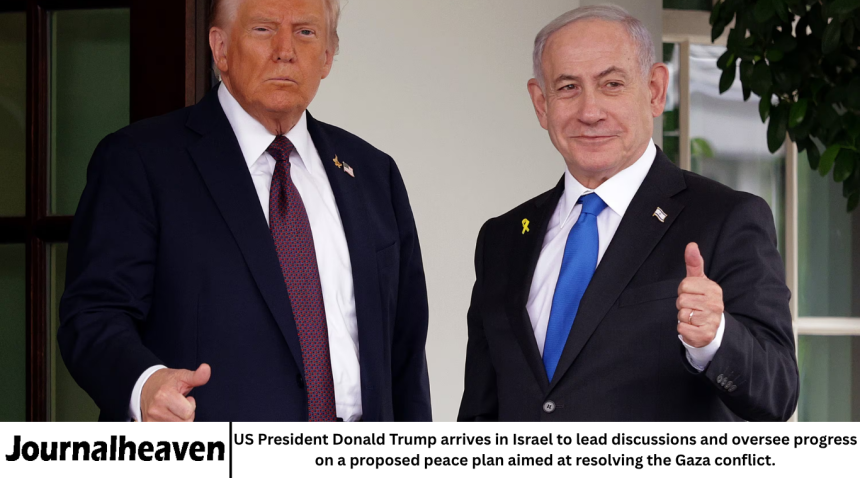The arrival of US President Donald Trump in Israel marks a new chapter in the long and complex history of Middle Eastern diplomacy. His visit aims to revive hopes for peace in the Gaza region, a conflict zone that has faced decades of political tension, humanitarian crises, and stalled negotiations.
- A Visit with Global Attention
- The Goals of the Peace Plan
- Trump’s Approach to Middle East Diplomacy
- Reactions from Israeli Leaders
- Palestinian Response and Expectations
- The Humanitarian Situation in Gaza
- Regional Reactions
- The Role of International Partners
- Security and Stability Concerns
- What Makes This Attempt Different
- Economic Development as a Path to Peace
- Challenges Ahead
- Media Coverage and Public Opinion
- A Moment of Possibility
- Frequently Asked Questions
- Conclusion
Trump’s return to active peace efforts has drawn attention worldwide, as leaders and observers watch closely to see if his direct involvement can bring about tangible progress where previous attempts have failed. The mission signals a renewed push by Washington to engage with both Israeli and Palestinian leaders in finding a framework for stability and coexistence.
A Visit with Global Attention
President Trump’s arrival in Israel was met with both optimism and skepticism. Crowds gathered in Jerusalem and Tel Aviv as his motorcade made its way through the streets, while international media closely tracked every development.
For some, Trump’s visit represents an opportunity to reset regional diplomacy. For others, it brings memories of past peace efforts that began with promise but ended in disappointment. Still, the symbolism of a sitting US president traveling to Israel with a focus on Gaza peace carries weight in a region where political gestures often speak louder than words.
The visit is not just about meetings — it’s about presence, tone, and timing. With tensions high and humanitarian needs growing, the world is watching to see whether this trip can open new pathways toward lasting peace.
The Goals of the Peace Plan
The proposed Gaza peace plan is centered around three main objectives: reducing violence, restoring humanitarian aid flow, and reopening diplomatic channels between Israel and Palestinian authorities.
Trump’s team has framed the effort as a practical step toward de-escalation, not a sweeping final deal. The plan aims to build incremental trust between both sides, using small but meaningful steps like coordinated ceasefires, easing of border restrictions, and rebuilding damaged infrastructure in Gaza.
Officials close to the process have described the plan as “results-driven” — focusing on actions over words. The idea is to show visible progress early, to create momentum and goodwill for future negotiations.
Trump’s Approach to Middle East Diplomacy
Donald Trump’s diplomatic style has always stood out. During his first presidency, he was known for his unorthodox, deal-oriented approach that broke from traditional diplomatic models. His administration brokered the Abraham Accords, which normalized relations between Israel and several Arab nations — a move that reshaped regional alliances.
This time, Trump appears to be building on that foundation. His strategy relies on personal relationships with key leaders and direct engagement rather than lengthy bureaucratic processes.
Supporters of his approach argue that his blunt, transactional methods cut through political gridlock. Critics, however, worry that the lack of traditional diplomatic structure could make lasting agreements harder to sustain.
Still, Trump’s re-entry into Middle East diplomacy brings undeniable energy and visibility to a process that has long struggled to move forward.
Reactions from Israeli Leaders
Israeli officials have cautiously welcomed Trump’s arrival. Prime Minister and senior government figures expressed appreciation for renewed US involvement, emphasizing that peace and security remain shared priorities.
Behind the scenes, however, there is awareness that the Gaza issue is one of the most delicate challenges facing Israel’s leadership. Balancing domestic political expectations, security concerns, and international pressure is no simple task.
For Israel, Trump’s visit provides both an opportunity and a test. If his mediation leads to concrete progress, it could boost regional stability. But if talks stall, it could fuel frustration among citizens who have lived through years of unfulfilled promises.
Palestinian Response and Expectations
The Palestinian response has been mixed. While some officials view Trump’s engagement as a potential avenue for relief and recognition, others remain cautious, pointing to past disagreements over US policy decisions in the region.
Many Palestinians are focused less on symbolism and more on tangible outcomes. They want to see improvements in everyday life — freedom of movement, access to basic resources, and meaningful economic opportunities.
Trump’s team has reportedly included economic measures in the peace plan aimed at supporting reconstruction in Gaza and improving job prospects for residents. For Palestinian communities weary of broken promises, progress will be measured not by speeches but by what changes on the ground.
The Humanitarian Situation in Gaza
The humanitarian crisis in Gaza remains one of the most urgent in the world. Years of conflict, blockades, and political division have left millions of residents facing poverty, food insecurity, and limited access to healthcare.
International aid agencies continue to call for stronger humanitarian corridors and sustained access for relief efforts. Trump’s plan includes provisions to facilitate aid delivery in coordination with regional and global partners.
Improving conditions in Gaza is not just a moral imperative — it’s a political necessity. Without addressing human suffering, no peace plan can gain the credibility or public support needed to succeed.
Regional Reactions
Neighboring countries, including Egypt, Jordan, and Saudi Arabia, have expressed cautious optimism about Trump’s mission. Many regional leaders see any renewed US involvement as potentially beneficial, provided it respects local dynamics and avoids one-sided policies.
Arab states that have normalized relations with Israel under the Abraham Accords may play a crucial role in facilitating communication and offering economic support for reconstruction projects. Their involvement could help bridge trust gaps and stabilize fragile diplomatic progress.
However, skepticism remains high. Regional analysts note that the Gaza issue is deeply rooted and complex — any quick-fix solution risks overlooking the long-term structural problems that fuel recurring violence.
The Role of International Partners
Beyond the region, international powers such as the European Union, the United Nations, and Russia are watching Trump’s visit closely. Global partners have long advocated for a two-state solution and balanced diplomacy that respects both Israeli and Palestinian rights.
Trump’s plan reportedly focuses on practical, short-term steps, but his administration may seek to integrate other powers into future phases of negotiation. Coordinated global support could help ensure that economic and humanitarian measures are properly funded and implemented.
At the same time, the involvement of multiple actors can complicate diplomacy if interests diverge. Success will depend on clear communication and shared objectives among all participating nations.
Security and Stability Concerns
Security remains the central challenge in Gaza. Repeated cycles of violence have eroded trust and left infrastructure in ruins. Both sides express a desire for safety, but deep-seated mistrust continues to shape policies and public sentiment.
Trump’s peace plan includes proposed frameworks for monitored ceasefires, designed to prevent flare-ups while allowing humanitarian and reconstruction work to proceed. Achieving even a temporary truce could lay the foundation for broader political discussions.
For Israel, maintaining security remains the top priority. For Gaza, gaining relief from military pressure and economic isolation is equally vital. Bridging those needs requires patience, accountability, and consistent oversight — something previous peace efforts often lacked.
What Makes This Attempt Different
Every peace initiative in the Middle East faces the shadow of past failures. However, Trump’s latest effort carries a few unique characteristics.
First, his previous success with the Abraham Accords gives him a record of unexpected breakthroughs in regional diplomacy. Second, his focus on small, measurable progress rather than sweeping political declarations could make this plan more realistic. Third, his ability to command media attention ensures that the issue remains visible, which could pressure all sides to act responsibly.
Whether these factors lead to real change remains uncertain, but they inject a sense of momentum into a situation that has long felt stagnant.
Economic Development as a Path to Peace
One of the central ideas behind Trump’s plan is that economic opportunity can pave the way for stability. The proposal reportedly includes investments in infrastructure, renewable energy, and job creation within Gaza.
The logic is simple: people are less likely to support conflict when they have hope for a better life. Economic incentives can create shared interests that transcend political divisions.
If implemented successfully, such measures could transform Gaza’s economy from one dependent on aid to one driven by productivity and innovation. But for that to happen, trust, transparency, and sustained international support will be essential.
Challenges Ahead
Despite the optimism, major obstacles remain. Political fragmentation between Palestinian factions, differing Israeli positions on security and territory, and regional rivalries all pose serious challenges.
Additionally, skepticism about Trump’s motives and methods could undermine participation from some stakeholders. Critics argue that his approach prioritizes speed and spectacle over depth and long-term planning.
Yet even with these concerns, the fact that Gaza is once again at the center of international focus brings renewed hope. Progress, even if slow, is better than silence.
Media Coverage and Public Opinion
Global media coverage of Trump’s visit has been intense. News outlets around the world are dissecting every statement and movement, trying to assess whether this effort will make a real difference.
Public opinion remains divided. Some believe Trump’s involvement could break political inertia, while others view it as another symbolic gesture with limited substance.
In both Israel and Gaza, citizens express cautious hope — a desire for peace tempered by years of disappointment. Many people simply want normalcy: safety for their families, freedom to travel, and the ability to build a future without fear.
A Moment of Possibility
The atmosphere surrounding Trump’s visit feels like a rare moment of possibility in a conflict often marked by despair. For the first time in years, leaders from both sides are talking about small steps toward peace rather than grand declarations.
If these talks produce even modest progress, such as improved humanitarian access or a partial ceasefire, it could change lives on the ground. That alone would be a significant achievement in a region where progress is often measured in inches, not miles.
Frequently Asked Questions
Why did Donald Trump visit Israel?
He visited Israel to oversee and advance discussions on a proposed Gaza peace plan aimed at reducing violence and improving humanitarian conditions.
What is the goal of the Gaza peace plan?
The plan seeks to promote security, rebuild infrastructure, and encourage cooperation between Israel and Palestinian authorities.
How have Israeli leaders reacted to Trump’s visit?
Israeli leaders welcomed his involvement, viewing it as a chance to strengthen diplomatic ties and explore new paths toward regional stability.
What is the Palestinian response to the plan?
Reactions are mixed — some see potential for progress, while others remain skeptical due to past experiences with US-led diplomacy.
How does this plan differ from previous peace efforts?
It focuses on small, achievable steps and practical results rather than broad political promises or final agreements.
What role do other countries play in this process?
Regional and international partners, including Egypt, Jordan, and the UN, are expected to support humanitarian and reconstruction efforts.
Can Trump’s visit lead to lasting peace?
While full peace is unlikely in the short term, even incremental progress toward reducing violence and improving living conditions would be a meaningful step forward.
Conclusion
President Donald Trump’s arrival in Israel to oversee a Gaza peace plan has reignited global debate about the future of the region. While challenges remain enormous, the renewed dialogue offers a glimpse of hope in one of the world’s most intractable conflicts.
Whether this initiative succeeds or falters will depend on trust, cooperation, and consistency — qualities that have long eluded past negotiations. But as long as leaders are willing to meet, talk, and act, there remains a path forward.
In a world where peace often feels distant, even the smallest steps toward understanding are worth celebrating. Trump’s visit reminds us that diplomacy, however imperfect, still holds the power to shape a better future for Gaza, Israel, and beyond.








